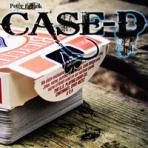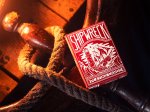Categories
- Instant Downloads -
- Black Label
- Book
- Card Magic and Trick Decks
- Christmas Themed
- Close Up Performer
- Comedy Performer
- Cups and Balls
- Dan and Dave Buck
- Decks (Custom, Standard)
- DVD
- Ellusionist -
- Escape Performer
- Gambling Performer
- Halloween Themed
- Illusionist
- Juggling Performer
- Kids Show and Balloon Performer
- Lectures and Conventions
- Limited Edition
- Magazines
- Magic Makers
- Mentalism,Bizarre and Psychokinesis Perf
- Mesika Levitations
- Miscellaneous
- Money Magic2
- Other
- Playing Cards
- Posters, Gifts and Collectables
- prohands
- Refills
- Religious and Gospel Performer
- Silk and Silk Magic
- Special Effects (Fire, Smoke, Sound)
- Sponge and Sponge Magic
- Stage / Parlor Performer
- Street Performer
- Tables and Cases
- The Blue Crown
- Theory 11
- Theory, History and Business
- TMS -
- Toy Magic (Toy, Kits, Puzzles)
- Trick
- Utility
- Walk Around Performer
- New Products ...
- Featured Products ...
- All Products ...
Features:
Scholars have pointed out that in Maya mythology, the gods and goddesses had different names and manifestations; stories occurred in assorted forms; scenes and figures shifted with confusing suddenness. However, beneath these seeming inconsistencies lay the shared belief that the universe was an orderly place and that proper behaviors toward the gods were crucial to maintaining its balance and harmony.
Inspired by Maya mythology, the deck comes in two variations differentiated by color scheme, named "The Sun Deck" and "The Moon Deck".
The Mayans were ardent astronomers. They believed that celestial bodies were gods and interpreted their movements as gods traveling among Earth, the underworld, and other celestial destinations. Since these gods were greatly involved in human affairs (to the point that many events were planned according to certain celestial moments; dynasties often claimed to have descended from the sun or the moon), the Mayans heavily studied every aspect of the sky, especially the sun and the moon.
About the Maya Sun:
The sun was of utmost importance to the Mayans.
The Maya sun god, Kinich Ahau, is one of the most powerful gods of the Mayan pantheon. He shines in the sky all day before transforming into a jaguar at night to roam the Maya underworld.
The Mayans were experts at predicting solar phenomena such as eclipses, solstices, and equinoxes.
The solar cycles formed the basis of the Maya calendar.
The Jokers use similar visuals to those on the boxes but against faded backgrounds:
The Ace of the Spade is distinguished by the illustration of Chichen Itza, a large pre-Columbian city built by the Mayans of the Terminal Classic period.
Chichen Itza, one of the largest Maya cities built, remains one of the most visited archaeological sites in Mexico today.
As for the back design, the symbol at the center is known as the Hunab Ku (or the Galactic Butterfly). Often depicted as a black-and-white spiral galaxy, it resembles the yin-yang symbol of Asia. Similarly, it represents the harmonious merging of opposites, the duality in all things, and the one and only God. Serving as a bridge that connects goodness and evil, men and women, life and death, consciousness and unconsciousness, etc., the Hunab Ku is a symbol of order, balance, wholeness, unity, and the conservation of energy in the universe.
The ring-shaped patterns are made up of Maya glyphs (artistically rendered). They represented words or syllables that could be combined to form any word or concept in the Maya language.
The tuck box is protected & decorated by a packaging sleeve with hollowed-out design.
"The pantheon of the Maya is a vast collection of deities worshipped throughout the regions of Yucatan, Quintana Roo, Campeche, Tabasco, and Chiapas in Mexico and southward through Guatemala, Belize, El Salvador, and Honduras. These gods informed the lives and rituals of the people, established order, and provided hope of a life after death."
- Joshua J. Mark, "The Mayan Pantheon: The Many Gods of the Maya," World History Encyclopedia
- Foil and 3D embossing on tuck case
- Each face card features the original illustration of a Maya god or goddess
- Premium Pantone metallic ink on back
- Printed by Bacon Playing Card Company(BPCC) in China
Scholars have pointed out that in Maya mythology, the gods and goddesses had different names and manifestations; stories occurred in assorted forms; scenes and figures shifted with confusing suddenness. However, beneath these seeming inconsistencies lay the shared belief that the universe was an orderly place and that proper behaviors toward the gods were crucial to maintaining its balance and harmony.
Inspired by Maya mythology, the deck comes in two variations differentiated by color scheme, named "The Sun Deck" and "The Moon Deck".
The Mayans were ardent astronomers. They believed that celestial bodies were gods and interpreted their movements as gods traveling among Earth, the underworld, and other celestial destinations. Since these gods were greatly involved in human affairs (to the point that many events were planned according to certain celestial moments; dynasties often claimed to have descended from the sun or the moon), the Mayans heavily studied every aspect of the sky, especially the sun and the moon.
About the Maya Sun:
The sun was of utmost importance to the Mayans.
The Maya sun god, Kinich Ahau, is one of the most powerful gods of the Mayan pantheon. He shines in the sky all day before transforming into a jaguar at night to roam the Maya underworld.
The Mayans were experts at predicting solar phenomena such as eclipses, solstices, and equinoxes.
The solar cycles formed the basis of the Maya calendar.
The Jokers use similar visuals to those on the boxes but against faded backgrounds:
The Ace of the Spade is distinguished by the illustration of Chichen Itza, a large pre-Columbian city built by the Mayans of the Terminal Classic period.
Chichen Itza, one of the largest Maya cities built, remains one of the most visited archaeological sites in Mexico today.
As for the back design, the symbol at the center is known as the Hunab Ku (or the Galactic Butterfly). Often depicted as a black-and-white spiral galaxy, it resembles the yin-yang symbol of Asia. Similarly, it represents the harmonious merging of opposites, the duality in all things, and the one and only God. Serving as a bridge that connects goodness and evil, men and women, life and death, consciousness and unconsciousness, etc., the Hunab Ku is a symbol of order, balance, wholeness, unity, and the conservation of energy in the universe.
The ring-shaped patterns are made up of Maya glyphs (artistically rendered). They represented words or syllables that could be combined to form any word or concept in the Maya language.
The tuck box is protected & decorated by a packaging sleeve with hollowed-out design.
"The pantheon of the Maya is a vast collection of deities worshipped throughout the regions of Yucatan, Quintana Roo, Campeche, Tabasco, and Chiapas in Mexico and southward through Guatemala, Belize, El Salvador, and Honduras. These gods informed the lives and rituals of the people, established order, and provided hope of a life after death."
- Joshua J. Mark, "The Mayan Pantheon: The Many Gods of the Maya," World History Encyclopedia
This product was added to our catalog on Monday 07 November, 2022.
Important Links
Testimonials
Quick And Awesome
Its true & real
Buying decks
I can't thank TMS enough. The delivery is awesome. Great items and quality. Not to mention prices.
Read More...
Its true & real
Mr. jockson. Thank you. i finally believe this site is true and trustful. i just received my props safety and sound. and about the no stock, you can...
Read More...
Buying decks
I will be buying decks from here since many people say that this shop is good........(and cheap too)
Read More...
Featured [more]

Cased by PE Illusions
RM111.25
Your IP Address is: .
Copyright © 2007 - 2025 The Magic Street.

